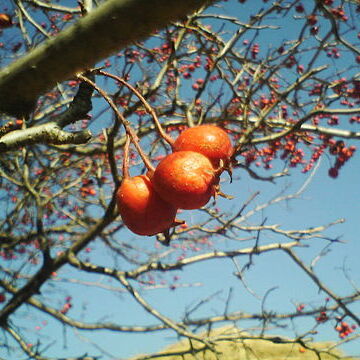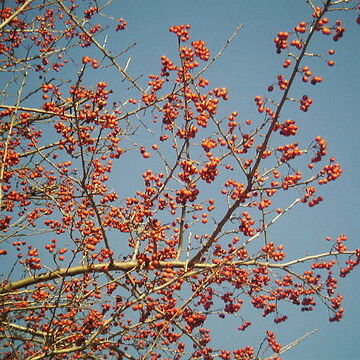Trees deciduous, to 6 m tall, with thorns 1–2 cm or sometimes unarmed. Branchlets purplish brown when young, grayish brown when old, terete, subglabrous or glabrous when young; buds purplish red, triangular-ovoid, glabrous. Stipules falcate, ca. 8 mm, herbaceous, margin serrate, apex acuminate; petiole 2–6 cm, glabrous; leaf blade dark green adaxially, broadly ovate or triangular-ovate, rarely rhomboidal-ovate, 5–10 × 4–7.5 cm, lateral veins 6–10 pairs, usually extending to apices of lobes and to sinuses between lobes, abaxially sparsely pubescent along veins, adaxially lustrous, base truncate or broadly cuneate, with 3–5 pairs of lobes, margin sharply irregularly doubly serrate, apex shortly acuminate. Corymb 4–6 cm in diam., many flowered; peduncle initially pubescent, glabrate, bracts caducous, linear-lanceolate, membranous, apex acuminate. Pedicel 4–7 mm, initially pubescent, glabrescent. Flowers ca. 1.5 cm in diam. Hypanthium campanulate, abaxially grayish white pubescent. Sepals triangular-ovate to lanceolate, 4–5 mm, both surfaces glabrous, apex shortly acuminate. Petals white, obovate or suborbicular, 7–8 × 5–6 mm. Stamens 20. Ovary 5-loculed, with 2 ovules per locule; styles 3–5, pubescent basally. Pome dark red, subglobose or pyriform, 1–2.5 cm in diam., glabrous; sepals persistent; pyrenes 3–5. Fl. May–Jun, fr. Aug–Sep. 2n = 34*, 102*.
More
A small tree. It grows 6 m high and spreads 6 m wide. The leaves are bright green and have lobes. There can be 9 lobes and they have teeth. The leaves are pale green underneath and they turn yellow in autumn. The flowers are white. The fruit occur in clusters and are bright red. There are several named cultivated varieties.



